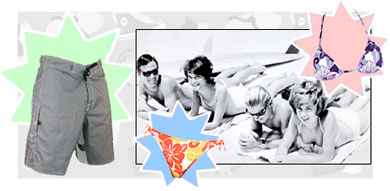Surfer

Fashion Synopsis
Life’s a Beach…
And then you surf. Man has overwhelming desires to explore the unknown, to understand the world in which he lives. The Wright Brothers soared over the sky, Mercury challenged outer space, and surfers mastered the wave. Once the ancient sport of Hawaiian kings, modern surfing became synonymous with the slacker lifestyle. But it wasn’t laziness that drove these surfers to a lifetime at the beach—they were searching for the most elusive of human desires: bliss.
The center of the surfing universe was Waikiki in Oahu, home of walking on water. 15th century surfers in Hawaii were magic men, riding the waves and challenging death at every turn. Surfing was an elite activity, reserved only for shamen who could appease the water gods enough to survive atop a plank of wood, riding the crest of a wave.
By the turn of the century, Hawaii’s sport became a tourist attraction, and in 1907, Hawaiian surfer George Freeth was brought to Redondo Beach, California, to demonstrate surfboard riding as a publicity stunt. After his assignment, Freeth stayed in California, hitting the waves as a surfing phenom and a lifeguard. Surfing would remain a selective sport for only the most diehard fans, but then along came Gidget.
California debuted more than a perky blonde Sandra Dee when Gidget hit the screens in 1959. The coastline and the crazy kids flying on water got more attention than the bikini babes did, and surfing set sail to become the phenomenon it is today. California became the new home to surf fans, and gremmies (surf wannabes) hit the waves for some fun in the sun. Gidget paved the way for all the Frankie and Annette Beach Party movies of the 60’s, which would turn surfing into a sensation. Overnight, the beaches were packed with bikini babes and moondoggie clones all balancing precariously on a wooden longboard.
Two California surfers, Dale Velzy and Hap Jacobs, started making their own balsa boards, paving the way for surfing to become available to everyone. Surfing had ridden a wave, and there was no wipeout in sight when the Beach Boys, Jan and Dean, and Dick Dale and the Deltones rocked out with surf sounds.
The surfers embraced a laid-back lifestyle, but die-hards could flash more than a little aggression when gremmies tried to ride waves on a “Locals Only” beach. No signs were hung to indicate which beach belonged to which group, but rest assured, if you infringed, you’d find out soon enough.
Surf fashion was also generally laid-back, but some spots required a bit extra. Sure, when the water’s warm, a pair of board shorts and bare skin is all you need, but when you’re surfing in the icy waters of the North Bay California, that bare-bones outfit just wouldn’t cut it. O’Neill and Body Glove were the first to make neoprene wetsuits in the 50’s, insulating the wearer from icy waters and making surfing a whole lot easier. Now surfers could brave any kind of water without turning into a human popsicle.
In the beginning, surfwear was just an old pair of swimming trunks, or a pair of cutoff jeans paired with a Hawaiian shirt or simple cotton tee. Then came Hang Ten, the first board shorts made specifically for the surfing lifestyle. Hang Ten shorts quickly achieved mass market appeal, opening the fashion channels to the growing subculture of surfers. Hang Ten expanded into fashion wear, and then more labels came out: Op, Lightning Bolt and smaller manufacturers like Jams made surf wear as well as casual clothes for a 24-7 style.
The 80’s surf culture was so hot that companies coast to coast tried to cash in with the next newest label: Gotcha, Quiksilver, Rude Dog, T&C, PCH, Maui & Sons and countless others were vying for rack space in their race to the shore. Vans made wildly-patterned surf shoes, and Jams made even more outrageous long surf shorts. It didn’t matter if you lived on the beach or were landlocked in Iowa, looking like a surfer was radical.
Surf wear reflected the casual lifestyle of the surfers: flip-flops were the only shoes in the closet (if any were worn at all); t-shirts plastered with bold surf logo graphics were king for easy-on easy-off comfort and elitist decoration; and board shorts were interminably damp, fresh from the water. Sun-bleached hair was styled with a fresh sea breeze, and the only coat that was ever worn was a slick layer of suntan oil for a deep, rich tan.
Girls got into the surf action, borrowing their clothes from the boys in the 80’s, when unisex surf tees, Jams shorts and Vans were the surf uniform. But by 1990, surf wear was geared for girls as well. Now more than observers, it was the girls who were keeping the sport alive. Surf labels like Quiksilver and Gotcha produced Roxy and Girlstar, respectively, made just for girls.
Although fashions change, time doesn’t, and surfers still seek the ultimate bliss via a surfboard. Forget 9 to 5, the rat race, and suburban white picket fences. From the start of the surfing obsession for the next hundred years, kids sacrificed everything for the perfect wave. Well, everything except style.
